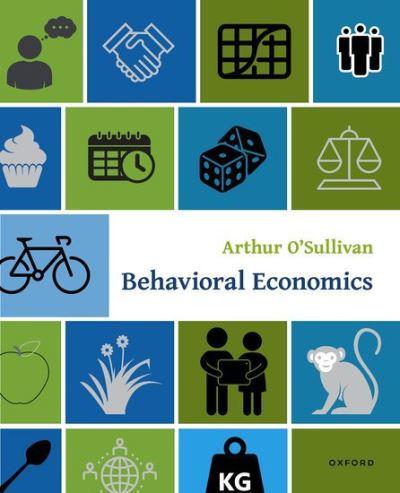Behavioral Economics
- ISBN: 9780197515921
- Editorial: Oxford University Press
- Fecha de la edición: 2022
- Lugar de la edición: Oxford. Reino Unido
- Encuadernación: Rústica
- Medidas: 25 cm
- Nº Pág.: 472
- Idiomas: Inglés

The text is designed as the main text for an undergraduate course in Behavioral Economics, which is a growing course for students of economics at the undergraduate level. The presentation is grounded in microeconomics and traditional economic models to discuss observed human behavior. The book presents models that show the trade-offs between material benefits and social concerns. The models incorporate social concerns such as altruism, guilt, exploitation, fairness, and cognitive dissonance. Unlike many other books on behavioral economics, the text is not a catalog of human quirks. Although the book highlights all sorts of observed behavior that appears irrational and misguided, it doesn't stop there. It examines the possible motives for the puzzling behavior. For many misguided and regrettable choices, we highlight actions taken to control the behavior and mitigate the damage. We use the insights of anthropologists and economists to explore the role of natural selection in shaping human thinking and behavior. A decision that appears irrational today may be understandable in the context of millions of years of natural selection. Recent work explores the role of natural selection in (i) loss aversion, (ii) the endowment effect, (iii) time preferences, and (iv) responses to the free-rider problem.
Part 1: Introduction
Chapter 1. Introduction & Key Concepts of Microeconomics
1. What is Behavioral Economics?
2. Key Concepts of Microeconomics
Opportunity Cost
The Marginal Principle
The Equimarginal Principle
Nash Equilibrium
Comparative Statics
Pareto Efficiency
Lotteries and Certainty Equivalent
Chapter 2. Insights from Behavioral Science
1. Social Preferences and Norms
Adam Smith and the Impartial Spectator
Rule Following Task: Avatar Pedestrian
Sharing the Rewards of Collaboration
Incurring a Cost to Enforce a Social Norm
The 50-50 Norm
2. Mental Shortcuts
Mental Accounting
Default Options
3. Cognitive Bias
The Decoy Effect
Present Bias
4. Problems with Probabilities
Rare Events
Gambler's Fallacy
5. Instincts and Deliberation
Apple versus Cupcake
Hunting Practices of the Ju/'hoansi
Why Do We Do That?
Appendix to Chapter 2
1. Anchors
2. Confirmation Bias
3. Overconfidence Effect
4. Availability Heuristic
Part 2: Social Preferences
Chapter 3. Social Norms: Sharing and Enforcement
1. Utility Maximization with a Social Norm
2. Sharing Behavior: The Dictator Game
Game Structure and Results
Variation in Sharing Behavior
3. Norm Enforcement: Ultimatum Game
Game Structure
Norm-Sensitive Responder
Equilibrium Responder Share
Norm-Sensitive Proposer
4. Results from Ultimatum-Game Experiments
Meta Analysis of Ultimatum Experiments
Crosswalk Rules and the Ultimatum Game
Competition Between Responders
Widget 3.1: Equilibrium in the Ultimatum Game
Chapter 4. Trust
1. The Trust Game: Investment & Production
Game Structure
Outcome in the Absence of a Sharing Norm
2. Sharing Norm for the Producer
Producer's Tradeoff
Varying Norm Sensitivity and Return Fractions
Investor Decision
3. Sharing Norm for the Investor
Investor's Tradeoff
Relative Norm Sensitivity and Equilibrium
Social Norms, Efficiency, and Social Capital
4. Experiments and Implications
Experimental Results
Trust Game and Social Capital
Trust Game and Oxytocin
Chapter 5. Public Goods
1. Free Riding and Experiments
The Free-Rider Problem
Results from Voluntary-Contribution Experiments
2. Social Norms and Voluntary Contributions
Norm: Efficient Choice
Norm: Equal Contribution
Explaining a Path of Decreasing Contributions
3. Punish Free Riders?
Punishing Norm Violators
Summary of Experimental Results
Chapter 6. Reciprocity in the Workplace
1. Worker Reciprocity and Social Capital
Perfect or Imperfect Information in the Workplace?
Social Norms and Pareto Improvements
2. Worker Identity and Effort
Utility-Maximizing Effort
Insiders versus Outsiders
Norm Sensitivity and Effort
Producer Investment in Identity Management
3. Response to a Higher Wage
Wages and a Sharing Norm
Wages and the Work-Effort Norm
Wages and Profit
4. Evidence of Worker Reciprocity
Field Experiments
A Gift-Exchange Experiment
Chapter 7. Voluntary Prices
1. Voluntary Prices: Pay What You Want
The Equal-Sharing Price and Norm-Violation Cost
Variation in Norm Sensitivity
Sustainability of PWW Systems
Economic Experiment: Pay What You Want versus Pay it Forward
Widget 7.1 PWW Price and Social Norms
2. Public Broadcasting: Free Riders and Punishing Pledge Drives
Payoffs to Members and Free Riders
Choosing the Length of a Pledge Drive
Chapter 8. Imitation and Cultural Learning
1. Imitation and Conformity
Over-Imitation by Humans
Over-Imitation: Humans versus Chimpanzees
Conformity and Matching Pennies
2. Faithful Imitation and Cultural Learning
Manioc and Obscure Production Processes
Social Learning: Humans versus Chimpanzees
Part 3: Time Preferences
Chapter 9. Discounting and Present Bias
1. Conventional Discounting and Present Bias
The Quasi-Hyperbolic Discount Function
Widget 9.1 Conventional Discounting and Present Bias
Present Bias & Doubling Your Apples
Time Inconsistency
Time Inconsistency and the Relative Values of Bundles
Present Bias and Regret
2. Estimates of Discounting Parameters
Estimates of Conventional Discounting and Present Bias
Economic Experiment: Patience Among Mothers and Children
Widget 9.2 Roll Your Own Current Value
3. Illustrations: Cupcake, Weed, Bucket List
Cupcake versus Apple
Homeowner versus Weed
The Bucket List
Chapter 10. Time Preferences and Saving
1. Discounting and Intertemporal Choice
Saving and the Equimarginal Principle
Widget 10.1 Discounting, Present Bias, and Saving
Present Bias and Regret
2. Saving Mandates and Nudges
Response to Mandate: Active Saver
Response to Mandate: Non-Saver
Nudges: Defaults, Save More Tomorrow, and Saving Lotteries
3. Clueless versus Savvy Consumers
Three-Period Model of Intertemporal Choice
Consumption Path of the Clueless (Naive)
Widget 10.2: Three-Period Consumption Program
Regret of the Clueless
Consumption Path of a Savvy Consumer
Commitment Devices and Saving
4. Present Bias and Pre-Commitment by Pigeons
Chapter 11. When to Act
1. Procrastination: Waiting Too Long
Present Bias and a Clueless Decision Maker
Conditions for Procrastination
Widget 11.1 Present Bias and Procrastination
Self Awareness and Procrastination
Clueless versus Self-Aware: How to Tell the Difference
2. Preproperation: Acting Too Soon
Present Bias and a Clueless Decision Maker
Conditions for Preproperation
Self Awareness and Preproperation
Chapter 12. Application of Present Bias—Sin Taxes and Fertilizer
1. Personally Harmful Products & Sin Taxes
A Model of a Personally Harmful Good
Present Bias and a Personally Harmful Good
Price and Consumer Choice
Savvy Consumers and Hobbling
Support for Sin Taxes
Widget 12.1 Present Bias and a Sin Tax
2. Present Bias and Fertilizer Investment
Review of Intertemporal Choice Model
Present Bias and the Fertilizer Investment
Policy Options
Part 4: Mental Accounting and the Endowment Effect
Chapter 13. Mental Accounting for Consumers
1. Mental Accounting and Fungibility
Consumer Budgets and Fungibility
Mental Accounting and Coupons
2. Other Implications of Mental Accounting
Mental Accounting and Sunk Cost
Decoupling Cost and Benefit: Credit Cards and Ride-Hailing Services
Regular versus Premium Gasoline
Chapter 14. Loss Aversion and the Endowment Effect
1. Painful Loss and Loss Aversion
Conventional Benefits and Costs of Exchange
The Pain of Loss Exceeds the Joy of Gain
Loss Aversion Parameter
Loss Aversion and Reappraisal
2. The Endowment Effect
Classic Endowment Experiment
Evidence for the Endowment Effect
Endowment Effect for Chimpanzees and Capuchin Monkeys
The Endowment Effect and Asset Exchange
Part 5: Risk Preferences
Chapter 15. Risk Preferences and Prospect Theory
1. Three (of Four) Features of Prospect Theory
Utility Function for Prospect Theory
Widget 15.1 The Shape of the Utility Curve
Utility Value and Certainty Equivalent
Widget 15.2 Utility Value & Certainty Equivalent
2. Risk Aversion and Risk Neutrality
Risk Aversion and the Risk Premium
Risk Neutrality: Linear Utility and No Loss Aversion
Sources of Risk Aversion
3. The Values of Key Parameters
Loss Aversion
Decreasing Sensitivity to Gain and Loss
Widget 15.3: Compute Your for Gain and Loss
Measuring Sensitivity to Stimulus
Experiment: Risk Preferences and Cognitive Ability
4. Risk Preferences of Rats
Chapter 16. Problems with Probability
1. Probability in Prospect Theory
Prelec Probability Weighting
Psychological Foundations
Widget 16.1 The Graphics of Probability Weighting
A Closer Look at Rare Events
2. Learning by Description versus Learning by Experience
3. Solving Puzzles with Probability Weighting
The Numbers Game Puzzle
The Longshot Puzzle
Chapter 17. Prospect Theory & Asset Markets
1. Decreasing Sensitivity and Attitudes Toward Risk
Decreasing Sensitivity to Gain and Risk Aversion
Decreasing Sensitivity to Loss and Risk Seeking
Constant Sensitivity and Risk Neutrality
Widget 17.1 Reservation Prices for Gain & Loss Lotteries
2. Disposition Puzzle
Reservation Price in a Winner Market
Reservation Price in a Loser Market
Reservation Prices and Time on the Market
Evidence for the Disposition Puzzle
3. Disposition Puzzle Disappears?
Let Bygones be Bygones
Constant Sensitivity to Gain and Loss
4. The Equity Premium Puzzle
Loss Aversion and Utility Values
Professional Traders: Too Much Information?
Widget 17.2 Equity Premium Puzzle
Chapter 18. Prospect Theory and Insurance
1. Willingness to Pay for Insurance
Decreasing Marginal Disutility of Loss
Certainty Equivalent & Willingness to Pay for Insurance
Willingness to Pay for Insurance versus Break-Even Price
Economic Experiment: Willingness to Pay for Insurance
Widget 18.1: WTP versus Price of Insurance
2. Probability Weighting and Insurance Puzzles
Decreasing Sensitivity and Probability Weighting
Widget 18.1 Hazard Insurance
The Hazard Insurance Puzzle
3. Insurance Deductible Puzzle
Insurance Deductibles
Surprise Loss Aversion
Chapter 19. Reference Points and Goals
1. Goals and the Marginal Principle
Goal-Related Marginal Benefit
Full Marginal Benefit and Choice
Goals on the Golf Course
2. Applications: Rainy Day Taxis and Abstinence
Rainy Day Taxi
Widget 19.1 Regular versus Goal-Oriented Taxi Drivers
Abstinence
Part 6: Natural Selection and Human Behavior
Chapter 20. Natural Selection & Behavioral Economics
1. Background Concepts from Evolutionary Biology
DNA, Genetic Mutations, and Natural Selection
Illustration: A Fire-Building Manual
2. A Closer Look at Fitness and Evolution
Fitness, Natural Selection, and Evolution
Fitness Contests and Geometric Mean Fitness
Economics versus Biology: Spider Somersaults
3. Genes, Environment, Norms, Culture, and Cognition
Genes and the Environment
Genes and Culture
Genes and Social Norms
Instinctive Urges versus Deliberation
Chapter 21 Natural Selection and Cooperation
1. Humans versus Chimpanzees
Cooperation: Skills and Motivation
Sharing
Willingness to Enforce Norms
Natural Selection and Cooperation
2. Consumption and Production Benefits of Cooperation
Benefits from Consumption Smoothing
Benefits from Economies of Scale
3. The Co-Evolution of Genes and Culture
Genes and Culture
Cultural Learning
Chapter 22. Natural Selection, Loss Aversion, and Time Preferences
1. Natural Selection and Loss Aversion
Steady versus Fluctuating Reproduction
Gain Equals the Loss
Gain Exceeds the Loss
Fitness Equivalence
Environmental Conditions and Genetic Mixes
Widget 22.1: Fitness and Loss Aversion
2. Natural Selection & Time Preferences
Tradeoffs from Investment
Low Investment Productivity
High Investment Productivity
Lessons from Historical Data
Chapter 23. Natural Selection and Risk Aversion
1. Small Reward and Risk Aversion
Geometric Mean Fitness
Natural Selection and Risk Aversion
2. Large Reward and Risk Neutrality
Greater Fitness for Risk Takers
Natural Selection Favors Risk Taking
Fitness Equivalence
Risk Aversion in Bonobos, Shrews, and Other Creatures
Widget 23.1: Fitness and Risk Aversion
3. Subsistence and Risk Seeking
Subsistence and Risk Preferences
The Flexible Risk Preferences of Juncos
Chapter 24. Bargaining and the Endowment Effect
1. A Hunter-Gatherer Exchange Economy
Hunter-Gatherer Fitness
Edgeworth Box and Gains from Exchange
Bargaining and Equilibrium
2. Natural Selection: Bargaining Outcomes
Endowment Effect and Nash Equilibrium
Disagreement Value and the Nash Bargaining Solution
Endowment Effect and Group Fitness
Widget 24.1: Nash Bargaining, Fitness, and the Endowment Effect
Egalitarian Economy and the Endowment Effect








